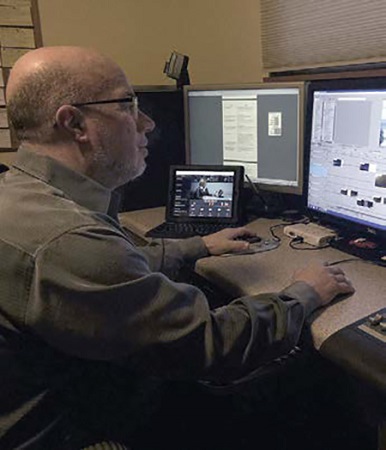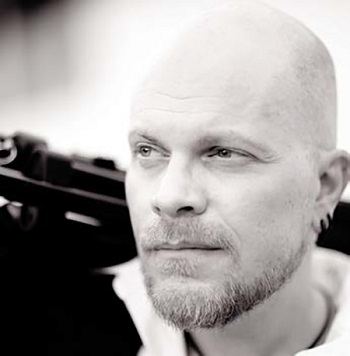Editors Find Big Things in An Inexpensive Package

Jay Ankeney Rarely do I run into as enthusiastic a cadre of editors than those who have chosen to adopt Sony Creative Software’s Vegas Pro as their mainstream NLE. These editors have discovered that Vegas Pro (basic edit package: $399.95, full Vegas Pro Suite: $799.95) not only has a very friendly GUI, but can perform tricks right from the beginning that are still available only on systems requiring a much higher level of capital investment.
“We’re actually a fairly small shop, relying on our own resources,” said Michael Bryant, director of marketing at Sony Creative Software, “but our biggest means of success is our very loyal following.”
Now on v13 since the 2014 NAB Show and strictly for Windows, Sony Vegas Pro was the first NLE that let you perform color grading on moving video; is one of the few that can convert almost any source material to 24P simply by dropping clips on the timeline; and, with enough computing/GPU power and RAM, is resolution-independent up to 4K. It was even the first NLE that offered a 3D workflow without additional hardware or rendering capability.

Rachel from the indie film “Sirens of Chrome” John P. Lauri, owner of J. Lauri Filmworks in Bloomfleid Hills, Mich., is in the process of posting the indie feature “Sirens of Chrome,” which is the first film concentrating on auto shows and the sleek models (now called “product specialists”) who adorn the car bodies on display.
Based on a screenplay inspired by the book by Margery Krevsky and scheduled for release in mid-2015, you can see more about the film at www.sirensofchrome.com.
“We shot in full HD mostly using Canon 5D Mark II and IIIs, a Sony FS700 and even some GoPro Heros,” said Lauri. “I had access to most major NLEs to post it, but my choice of preference was Sony Vegas Pro 13, primarily for its ability to convert source material seamlessly on the timeline. I do use a Cineform intermediate codec to optimize the footage for color correction before assembling the final master, but this drag-and-drop capability from the camera card lets us start editing right away.”

John Lauri This was crucial for the movie since Lauri’s globe-traveling crew shot footage in nine countries and 38 cities, from Detroit to Geneva to Beijing.
The professional video industry's #1 source for news, trends and product and tech information. Sign up below.
“All this collaboration was facilitated by a new app for Vegas Pro 13 called ‘Vegas Pro Connect,’ which enables a collaborative review process that I use to share my projects with other iPads equipped with VP Connect.”
In New York, Writer/Director/Editor Jerry Hartke is working on two features about the origins of Santa Claus (St. Nicholas) for production company Nicholas of Myra LLC. The first one, called “Nicholas of Myra, the Legend Begins” (www.nicholasofmyra-movie.com), due out in November will have been edited and finished using Vegas Pro software. The film is being shot in 4K using a proprietary camera configuration that packs six HDV (1080x1440) overlapped sensors into Sony Z1 and FX1 cameras, resulting in a panoramic 2.35:1 aspect ratio with a true frame resolution just under 4320 x 2160.

The film “Nicholas of Myra, the Legend Begins” is due out in November.
Hartke has been using Vegas Pro software ever since it was developed by Sonic Foundry in 1999 as an audio editor (v2 was the first video NLE incarnation in 2000); and is using it for everything from editing to motion tracking to compositing and even mixing the sound in Dolby Digital 5.1.
“The bang for the buck is the amazing thing in Vegas Pro,” Hartke said. “Its color-grading capabilities are far above what you would expect just using the Sony presets. But, best of all, the user-friendly GUI presents all you need on one screen.”
Hartke is intentionally going for a big-screen Technicolor look on “Nicholas of Myra” but with muted colors to evoke its historic content. “For a pair of independent films on our kind of budget,” he said, “Vegas Pro makes an elaborate production like ours possible.”
In his mind, this is epitomized by his ability to color grade the red robes that Nicholas wore as a Bishop of the Church and later became a signature part of his image.

Jerry Hartke

Raymond Schlogel “We were able to get a rich red that pops vibrantly without bleeding,” he said. “You can imagine how important that was for our main character, and we were able to create this look in real time using Vegas Pro while watching moving video. That is really saving our bottom line.”
At Underground Planet in Austin, Texas, Ray Schlogel uses his Sony Vegas Pro software on lots of award-winning music videos and independent films. You can see some of his work at www.vimeo.com/undergroundplanet.
Like many other Vegas editors, Schlogel can’t say enough about it. “This is the NLE that others are still catching up with,” he laughed. “Even from the beginning you could set up cross fades simply by dropping clips on the timeline and dragging the mouse over them to adjust the length. Of course, you can also enter specific numbers, but this way is much more intuitive.”
Schlogel credited Vegas as the first NLE that could decode the RED 4K .R3D files before anyone else. “I even demonstrated this at the first REDucation training program back in 2009 and the guys operating the other brands of NLEs were blown away that we could just edit directly from the RED camera card without any proxies or transcoding. I’m pretty certain Sony Vegas was the first to be able to do this.”
Schlogel said Vegas Pro is more than just a tool. “I would not be doing what I am doing now without Vegas Pro,” he said. “You can sense the camaraderie just reading the Sony Forums about it.”
Author’s note: This column has always tried to remain objectively agnostic about different NLEs so it’s not my intent to endorse anything. But I will be making a pilgrimage to the Central Hall at the 2015 NAB Show to find out what new ideas SCS has come up with for the next version of Sony Vegas Pro.
Jay Ankeney is a freelance editor and post-production consultant based in Los Angeles. Write him atJayAnkeney@mac.com.
